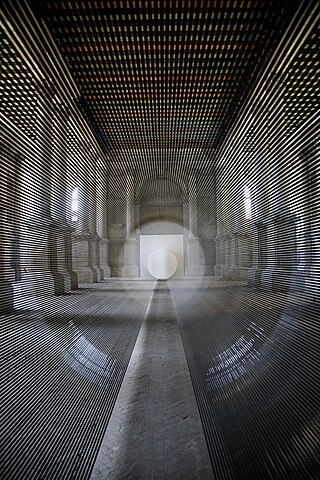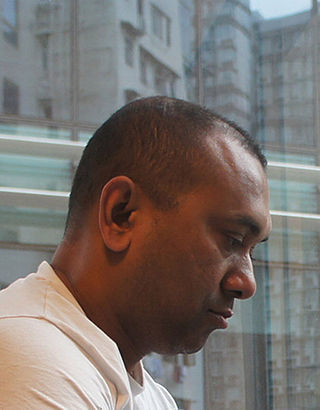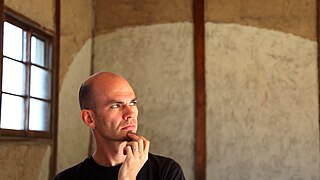Janet Laurence is an Australian artist, based in Sydney, who works in photography, sculpture, video and installation art. Her work is an expression of her concern about environment and ethics, her "ecological quest" as she produces art that allows the viewer to immerse themselves to strive for a deeper connection with the natural world. Her work has been included in major survey exhibitions, nationally and internationally and is regularly exhibited in Australia, Japan, Germany, Hong Kong and the UK. She has exhibited in galleries and outside in site-specific projects, often involving collaborations with architects, landscape architects and environmental scientists. Her work is held in all major Australian galleries as well as private collections in Australia and overseas.
MAD Architects is a global design practice led by founder Ma Yansong, and partners Dang Qun, and Yosuke Hayano. MAD Architects boldly challenges conventions in thought, action, and spirit by pushing the boundaries of architecture, urbanism, interior and product design, fashion, and art. With offices located in Los Angeles, Rome, and Beijing, MAD's strength and inspiration comes from a team of over 150 architects and designers from 15+ countries representing all walks of life from every corner of the world.
Grizedale Arts is a contemporary arts residency and commissioning agency based in Cumbria, England. Its primary artists' residency space is the former hill farm Lawson Park, sited on the edge of Grizedale Forest in the central Lake District. It also owns and runs a hybrid pub / arts centre The Farmer's Arms at Lowick, a listed building that was purchased with the support of investors and donors during the Covid19 pandemic. Grizedale Arts produces cultural projects locally, nationally and internationally with a particular focus on Japan, where a number of significant long term projects in rural communities have evolved. The focus of the organisation is on developing emerging artists and producing experimental projects that demonstrate the function of art as an everyday aspect of a worthwhile and productive life. The organisation is financially supported by Arts Council England. Adam Sutherland MBE, director since 1999, guest-curated 'The Land We Live In, The Land We Left Behind' for Hauser & Wirth Somerset in 2018, a major historic and contemporary survey of rural cultures that attracted over 40,000 visitors to the galleries in Bruton.

Marco Mario Paolo Casagrande is a Finnish architect, environmental artist, architectural theorist, former mercenary, writer and professor of architecture. He graduated from Helsinki University of Technology department of architecture (2001). Casagrande has been identified as an anarchist architect.
Tomoko Konoike (鴻池朋子) is a Japanese contemporary multimedia artist. She is best known for her large-scale installations and Nihonga-style surreal paintings.

Žilvinas Kempinas is a contemporary visual artist. He lives and works in New York City.
Kingsley Ng is an interdisciplinary artist working primarily on conceptual, site-specific and community-oriented projects. Ng crafts relationship between the work and its context through media and formats including interactive installation, public workshop, sound, spatial design and experiential design.
Chiharu Shiota is a Japanese performance and installation artist. Shiota has lived and worked in Berlin, Germany since 1996. Educated in Japan, Australia, and Germany, Shiota interweaves materiality and the psychic perception of the space to explore ideas around the body and flesh, personal narratives that engage with memory, territory, and alienation. Her signature installations, which consist of dazzling, intricate networks of threads stretching across gallery rooms, made the artist rise to fame in the 2000s. Shiota has exhibited worldwide. She made her debut in Japan at the Yokohama Triennale in 2001 with Memory of Skin and represented Japan in the 56th Venice Biennale in 2015.

Firoz Mahmud is a Bangladeshi visual artist based in Japan. He was the first Bangladeshi fellow artist in research at Rijksakademie Van Beeldende Kunsten in Amsterdam. Mahmud's work has been exhibited at the following biennales: Sharjah Biennale, the first Bangkok Art Biennale, at the Dhaka Art Summit, Setouchi Triennale (BDP), the first Aichi Triennial, the Congo Biennale, the first Lahore Biennale, the Cairo Biennale, the Echigo-Tsumari Triennial, and the Asian Biennale.

The Setouchi International Art Triennale is a contemporary art festival held every three years on several islands in the Seto Inland Sea of Japan and the coastal cities of Takamatsu and Tamano. The festival was inaugurated in 2010 with the aim of revitalizing the Seto Inland Sea area, which has suffered from depopulation in recent years, as well as long-standing environmental degradation from illegal industrial waste-dumping practices conducting during the 1970s following rapid industrialization in the area.
Albert Yonathan Setyawan is an Indonesian contemporary ceramic artist, living in Japan.

James Jack is a contemporary artist based in Japan.
Naoki Ishikawa is a Japanese photographer, writer, and mountain climber. Ishikawa first established himself as an accomplished climber, reaching all seven summits by 2001 in his early twenties. In 2001, he began to take photographs seriously and thereafter his ventures as a photographer and writer have intimately linked to his travels and climbs, as he often photographs and writes about his own adventures to various remote landscapes. Ishikawa's analog photographs frequently capture nature at its most extreme and the people that inhabit it, gaining a broad recognition for his ethnographic sensibility and curiosity, informed by his study of antholopology and ethnography at Waseda University.

Yusuke Nakahara was a renowned Japanese art critic, curator, scholar, lecturer, university president, art festival organizer, and cultural administrator.
Tatsuo Kawaguchi is a Japanese multidisciplinary artist, whose practice often involves the use of objects and the investigation of materials. After studying painting at Tama Art University, Kawaguchi's diverse oeuvre has included drawing, sculpture, installation, photography, and video. He also co-founded the Group "i", a Kobe-based artistic collective, in 1965.

Nobuho Nagasawa is a Japanese-born US-based transdisciplinary artist. Nagasawa is known for her site-specific installations involving in-depth research into the cultural history and memory, and extensive community participation. Her works were featured in international exhibitions including the Asian Art Biennial, the Sharjah Biennial, and the Echigo-Tsumari Art Triennial. She has exhibited extensively in galleries and museums in Asia, Europe, and the North America. The venues include, the Royal Garden of the Prague Castle, Ludwig Museum (Hungary), Rufino Tamayo Museum (Mexico), Sharjah Art Museum, Alexandria Library (Egypt), among others. Recipient of the 1997 Design Excellence Award for Architecture and Public Art, through the Cultural Affairs Office in Los Angeles, Nagasawa has been commissioned more than 20 public art projects, including projects in California, Washington, Texas, New York, and Japan. Nagasawa was previously Professor at the Claremont Graduate University, Scrips College, California (1992–1996) and Professor at the University of California, Santa Cruz (1996–2001), and has been Professor at the State University of New York at Stony Brook since 2001.
Yukihisa Isobe is a Japanese artist whose practice has been shaped by his professional interest for ethical ecology. Active and relatively successful as a young painter in the post-war avant-garde, Isobe appeared to abandon his artistic practice when he moved to New York in 1965 and began a career in urban and ecological planning. However, Isobe maintained his passion for the visual arts and began creating two-dimensional works again in the 1990s that now employed a graphic vocabulary of scientific signs and forms. Since its inaugural edition in 2000, Isobe has contributed monumental environmental installations to the Echigo-Tsumari Art Triennale, notably Where has the river gone? in 2000, revealing to spectators man-made changes in the landscape.
The arts festival Oku-Noto Triennale takes place every three years in Suzu, Japan. Contemporary artists install site-specific works in the city and surrounding countryside and region. During the event, local residents offer guided tours and lectures. The festival took place for the first time in 2017. Some of the works remain permanently on the site and are open to the public.
Yoshio Kitayama is a Japanese artist born in Shiga prefecture in 1948 and based in Kyoto. He represented Japan for the 40th Venice Biennale in 1982 and has participated in the Echigo-Tsumari Art Triennial and the Setouchi Triennial.
Can Tamura is an American artist, filmmaker and multimodal anthropologist based in Kanazawa, Japan.








